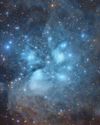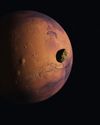
While Earth isn't free of destructive impulses - natural disasters, climate change, radioactive rocks and deadly viruses, to name but a few - it's a relatively safe haven for humans among the stars, hence why humans have managed to evolve to live here so successfully. But leaving the confines of our planet's protective atmosphere, the universe gets a lot deadlier. As it turns out, space isn't the most welcoming place for us Earth dwellers, with many ways the universe could wipe us all out in just the blink of an eye.
1 A GAMMA-RAY BURST MELTS THE ATMOSPHERE
Gamma-ray bursts (GRBs) are the most intense, high-energy radiation events in the universe, thought to be produced from explosive cosmic events like hypernovae, black hole formation and colliding neutron stars. Though these beams typically last just a few seconds, they release 10 billion years of solar energy in this tiny timeframe.
We've only observed GRBs in distant galaxies so far, but there's no reason the same physics couldn't apply in our Milky Way. If a nearby event triggered such a burst, and the electromagnetic beam was directed straight at our planet, we wouldn't feel any immediate effect. However, the intensity of the radiation would strip away the ozone layer of our atmosphere in mere seconds, leaving us vulnerable to cosmic rays and the full ultraviolet radiation that the Sun sends our way. And because of the split second nature of GRBs, it would be nigh impossible to predict when one could strike us. It also might not be the first time: a local GRB is one theory put forward to explain the Late Ordovician mass extinction - one of Earth's five major extinction events - which took place around 450 million years ago, wiping out 85 per cent of species in our primitive oceans.
2 MAGNETARS
Diese Geschichte stammt aus der Issue 128-Ausgabe von All About Space.
Starten Sie Ihre 7-tägige kostenlose Testversion von Magzter GOLD, um auf Tausende kuratierte Premium-Storys sowie über 8.000 Zeitschriften und Zeitungen zuzugreifen.
Bereits Abonnent ? Anmelden
Diese Geschichte stammt aus der Issue 128-Ausgabe von All About Space.
Starten Sie Ihre 7-tägige kostenlose Testversion von Magzter GOLD, um auf Tausende kuratierte Premium-Storys sowie über 8.000 Zeitschriften und Zeitungen zuzugreifen.
Bereits Abonnent? Anmelden

MYSTERIES OF THE UNI WHERE ARE ALL THE SPIRAL GALAXIES?
There are far fewer spiral galaxies than elliptical ones in the Supergalactic Plane, and scientists are keen to discover why

ZOMBIE STARS
+10 OTHER TERRIFYING SPACE OBJECTS

HOW TO BEAT LIGHT POLLUTION
Thought it was impossible to observe the wonders of the night sky from towns and cities? Think again. Follow our tips and tricks on successfully observing through sky glow

15 STUNNING STAR CLUSTERS
These beautiful stellar groupings are spattered across the cosmos

Eileen Collins "It was a difficult mission...we were the first to see Mir"
Having served as both the first female pilot and first female commander of NASA's Space Shuttle, Collins boosted the involvement of women in space exploration to a whole new level

MARS LEAKS FASTER WHEN IT'S CLOSER TO THE SUN
The Red Planet has lost enough water to space to form a global ocean hundreds of kilometres deep

FUTURE TECH KANKOH-MARU
This ambitious reusable spacecraft will be capable of taking 50 people to and from orbit

THE FINAL FRONTIER
Beyond the reach of the Sun is a fascinating region of the cosmos that were only just beginning to explore

A long-lost moon could explain Mars' weird shape and extreme terrain
A long-lost moon could explain why Mars is so different from the other rocky planets in the Solar System. Today Mars has two tiny moons.

A sprinkling of cosmic dust may have helped kick-start life on Earth
Cosmic dust may have helped kick-start life on Earth. New findings challenge a widely held assumption that this wasn't a plausible explanation.